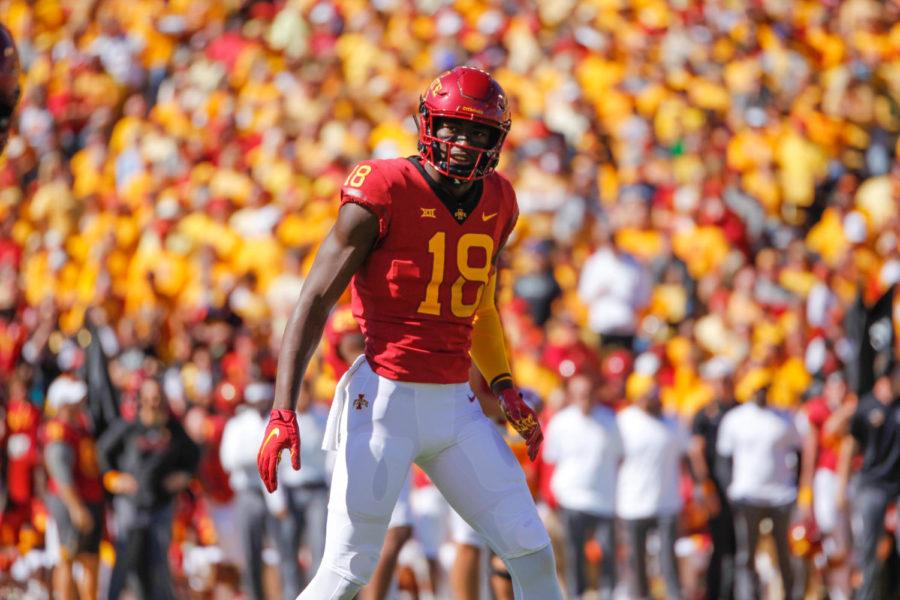NFL Draft: Where the experts project former Cyclones to go
April 24, 2019
A little over a month after March Madness brackets go up in flames, NFL mock drafts follow suit. One blockbuster trade or a few reaches or falls can derail draft analysts’ predictions.
While mock drafts are crapshoots, aggregating a handful of mock drafts can clarify team needs, individuals’ draft stocks and the order of players picked at specific positions.
The NFL Draft begins at 7 p.m. Thursday with the first round. At 6 p.m. Friday, the second and third rounds follow. The draft wraps up Saturday with rounds four through seven starting at 11 a.m.
For the first time since 2014, Iowa State should have a name-called on one of the three days and one or two more names could follow.
Hakeem Butler
Can the 6-foot-5 wide receiver really go on day one? The chances appear slim, but some analysts forecast Butler as a first-round pick in their latest mock drafts.
CBS provided six mock drafts of the first round next to each other, and all but one excluded Butler from the first round. Will Brinson picked the Green Bay Packers to grab Butler at No. 30 overall (in this situation he’d reunite with former Cyclone Allen Lazard).
Meanwhile, Jon Ledyard marked Butler as a first-round talent in his player evaluation of the tall wide receiver.
Chris Trapasso predicted the Buffalo Bills will pull the trigger on selecting Butler at No. 9 in his mock draft.
Pro Football Focus showed a more skeptical approach to Butler, sending a Tweet with its wide receiver rankings, which Butler landed sixth on.
PFF’s Final WR Rankings for the 2019 NFL Draft
1. DK Metcalf
2. AJ Brown
3. JJ Arcega-Whiteside
4. Andy Isabella
5. Marquise Brown
6. Hakeem Butler
7. Deebo Samuel
8. N’Keal Harry
9. Terry McLaurin
10. Riley Ridley
11. Diontae Johnson
12. Kelvin Harmon— Pro Football Focus (@PFF) April 24, 2019
While it’s tough to be certain of his draft stock with the unique set of skills he possesses, most analysts place Butler as a day one or day two talent.
So why does Butler appear extremely high in some mock drafts and low in others? Lance Zierlein of NFL.com provided insight to the positives and negatives of the former Cyclone.
Zierlein projects Butler as a second rounder and said, “Big long-strider with exceptional length and good build-up speed to challenge cover corners and safeties down the field. Butler’s unique play strength after the catch allows him to win contested deep balls and then plow through tackle attempts to create chunk plays and long touchdowns.”
On the flip side, Zierlein points out Butler’s average route running, but more importantly, that Butler struggles with drops at times.
David Montgomery
After a productive career at Iowa State, David Montgomery — like Butler — declared for the draft after his junior season.
Montgomery turned in the more consistent career of the two, but he’ll likely be selected after Butler due his position and lack of flashiness.
Some analysts bumped Montgomery into the second round, but most mock drafts project the former Cyclone to wind up in the third round or on day three.
Three analysts on The Draft Network graded him as a third-round talent, and one stamped a fourth-round grade on Montgomery.
Meanwhile, Zierlein is higher on Montgomery, projecting him to go in the second round. Zierlein compares Montgomery’s playing style to another former Matt Campbell-coached running back, Kareem Hunt.
Hunt and Montgomery showcase high-level balance in their toolboxes. Zierlein calls Montgomery “one of the safest runners in the draft” with a pro-ready game.
“He runs with impressive calm and instincts in the midst of interior mayhem, weaving and battering his way through traffic,” Zierlein writes. “Smart teams will recognize his ability to create yardage for himself with his eyes, footwork, contact balance and power.”
Zierlein and others’ knocks on Montgomery are mostly related to his lack of speed and explosiveness to outrun defenders. Montgomery’s also toted the ball a lot in the past two seasons, which isn’t a positive with the longevity of running backs’ careers.
Brian Peavy
Brian Peavy has an outside shot at being drafted on day three, but teams will be deterred from the cornerback early on because of his lack of size. Peavy’s listed at 5-foot-9, 194-pounds. The former Cyclone could latch onto an NFL team in a special teams role.
















